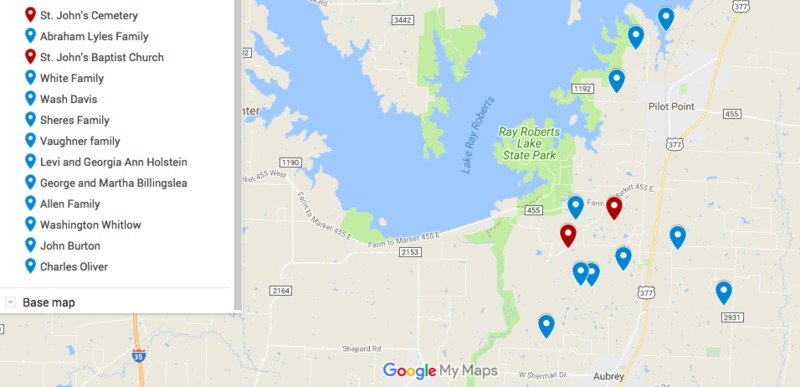St. John's as a Freedmen's Community
Born out of the horrors of slavery and the promises of emancipation, freedmen’s communities in the state of Texas arose out of the dual desires of recently freed African Americans to acquire land and autonomy from local whites. Typically organized around churches or schools, these communities possessed a unique name, established by the denizens of the community. Freedpeople primarily settled in two differing types of locations: first, on the periphery of towns, as far from the influence of local whites as possible, and second, on unsettled land in rural Texas, which local whites considered uninhabitable. Freedmen’s communities were distinct entities that came into existence in the decade after the Civil War and slowly faded away in the twentieth century as the Great Depression and Second World War as economic pressures pushed many African Americans into more urban areas in search of jobs.
St. John's may not fit the academic definition of a freedmen's community exactly, but we believe the best way to understand St. John's is through the lens of freedmen's communities. Thus, these pages serve to better explain the lives and experiences of the St. John's families by exploring the lives of other African Americans throughout the state of Texas. Viewing St. John's through the lens of a freedmen's community offers a unique analytical perspective from which to consider its history. Its origins and geographic area are unique among freedmen's communities in Texas, but the focus on farming and church life tied St. John’s into the larger context of other similar settlements in Texas.
St. John’s origins set it apart from the vast majority of freedmen’s communities in Texas because it was created during the 1870s and 1880s not by men and women who had been enslaved in Texas, for the most part, but by migrants who had recently been enslaved in Chambers County, Alabama, and Missouri. The migratory status of the members of the St. John’s community set them apart from the traditional settlement patterns seen in other freedmen’s communities, which mostly consisted of settling on land gifted by former slave owners or by creating impromptu squatter communities on unsettled land. Additionally, the community occupied a wide geographic area, which was atypical of many freedmen’s communities. Many of the other communities in the state occupied a small area and featured distinct community boundaries setting them apart from the local white populace.
However, St. John’s also had numerous aspects in common with and connections to other freedmen’s communities throughout Texas. The most prominent feature of the community was the St. John’s Baptist Church, which was the central focus of the community. Founded in the 1870s or 1880s, the St. John’s Church, and its corresponding cemetery, drew African Americans from the countryside around Pilot Point, binding them together. Many other rural freedmen’s communities throughout Texas had a church as the community's focal point. Further, the residents of St. John’s primarily engaged in agriculture and livestock raising as a means of subsistence, which directly mirrors other rural freedmen’s communities in Texas. The lack of manufacturing jobs available to residents of St. John’s provides an additional similarity to other rural freedmen’s communities, which often completely relied on agriculture to sustain themselves.
St. John’s also ended at a time and in a way that mirrors other freedmen’s communities in Texas. The community slowly faded out of existence during the 1930s as members left the area, presumably in search of better economic prospects. All that remains of the community today are the site of St. John's Cemetery and the memories of family members of dispersed former residents in nearby Pilot Point and other communities and other towns and cities around the DFW Metroplex. Many other freedmen’s communities met the same fate in the 1930s and 1940s. Today only the scattered memories of descendants and local churches marking the location of the once thriving settlements.
St. John’s is a unique community; it does not fit into the traditional academic definition or understanding of a freedmen’s community, but the farm economy and church focus tie it into the larger contexts of other freedmen’s communities, creating connections between it and other similar settlements. While St. John’s may not be best defined as a freedmen’s community, it is best understood in the context of one – as other freedmen’s communities can shed light onto the lives and experiences of the families of St. John’s.
